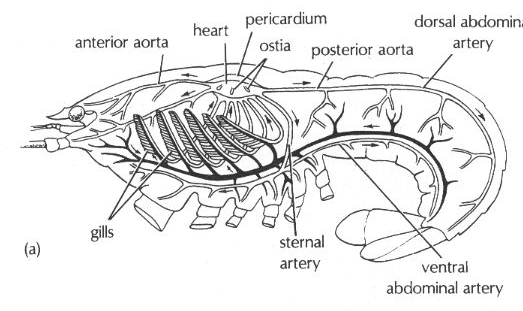
Arthropodsd
1. What characteristics according to your book define an arthropod.
Jointed hardened exoskeleton with intrinsic (contained) musculature between joints.
Complete loss of motile cilia in adult and larvae stages.
2. What type of circulatory system do they have?
What is meant by an open circulatory system varies among groups.

Circulations Can be Open or Closed or in some invertebrates lacking, with most of the exchange occurring via simple diffusion. You should realize the last few microns of all delivery systems is always done by simple diffusion. Diffusion is very effective but only over short distances.
| Distance Ave. Diffusion |
Time |
| Cell membrane thickness 1 micron | 0.0000001 sec. |
| Size of most bacteria or mitochondria 10 microns | 0.001 sec. |
| Diameter of large eukaryotic cells 250 microns | 10 sec. |
| Radius of giant squid axon 2 millimeters | 1 min. |
| Radius of mature ovarian follicle 2 centimeters | 7 hr. |
| Mammals 10 centimeters diameter |
120 days |
| Half height of humans 1 meter | 32 years |
3. How does their vision differ from ours?
Additional notes: Eyes are present in most arthropods. Not all arthropods have compound eyes. Simple eyes or ocelli are present in arachnids, the tiny crustaceans, and most myriapods. An ocellus is simply a small cup with a light sensitive surface backed by light absorbing pigment. The large crustaceans and insects have compound eyes, although many insects have simple eyes as well.
The lenses in compound eyes can't change focus, so insects can't see things that are far away. The compound eye is very good at seeing things nearby and detecting motion. Image processing is so much more efficient than in humnas. The compound eye offers a much greater flicker fusion rate. This means that an insect can assimilate changes in what it's seeing many times more quickly than we can. A magician's hand-tricks are transparent to insects, because the hand is not faster than the compound eye, and a Hollywood movie would look to an insect like a series of still photographs.
4. How does the innervation of their muscle differ from ours?
5. Hard exoskeletons and necessary molts
To grow, arthropods must molt because of their hard exoskeletons.
The molt has a major impact on arthropod life; by some calculations, an arthropod spends 90% of its life preparing to molt, molting, and recovering from the most recent molt.
Go through the lesson on exoskeletons. found on the Evo 101 website.
http://evolution.berkeley.edu/evolibrary/article/0_0_0/constraint_03 This exploration of the correlation of size and type of skeleton will form the basis of an essay question on the exam.
The exoskeleton is just the first step. Lets add legs.http://shapeoflife.org/video/other-topics/arthropod-locomotion-engineering Watch video.
Additional notes: The cuticle is secreted by the cellular epidermis. A single layer of epidermal cells secretes the exoskeleton*. In the majority of arthropods it is fashioned into a cuticle consisting of rigid plates connected by flexible cuticle. The cuticle is hardened by tanning, and in the case of the advanced crustaceans, e.g. crabs, also by the incorporation of calcium salts. Pore canals lead from the epidermis to the cuticular surface. The molting process is controlled by the hormone ecdysone which is produced by an endocrine organ and acts on the epidermal cells that secrete the cuticle. All cuticular structures are shed at ecdysis, including the terminal linings of the alimentary tract and of the tracheae (later, in Insecta) if they are present.
Major differences between insects and crustaceans in molt. In insects, ecdysone and other steroid production by the prothoracic glands is activated by brain via production of a hormone.
The titer of ecdysone and juvenile hormone (corpora allata) determine the stage in homometabolous insects.
Another diagram of the process
In crustaceans, ecdysteroid production seems to be inhibited by a hormone produced by a neurosecretory complex in the eyestalks.
In crustaceans, the molting inhibiting hormone arises from the X-organ sinus gland complex. MIH is a neuropeptide that inhibits the secretion of steroid ecdysone, from the Y-organ. The X-organ sinus gland complex controls molting by having inhibitory control over the Y-organ via molting inhibitory hormone (MIH).
Homework for Monday. Skim the rest of chapter 14 and answer the following question. What is tagmatization?
We will be going over groups and arthropod phylogeny on Monday.